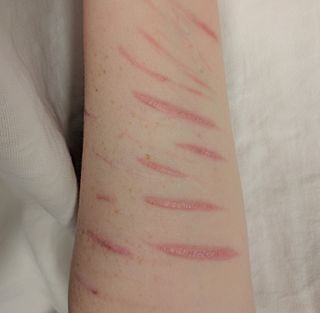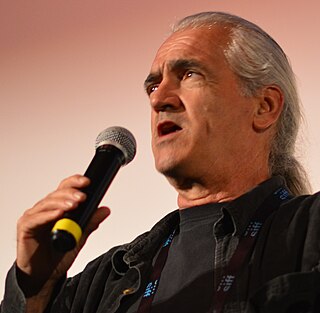
The Diagnostic and Statistical Manual of Mental Disorders is a publication by the American Psychiatric Association (APA) for the classification of mental disorders using a common language and standard criteria. It is the main book for the diagnosis and treatment of mental disorders in the United States and is considered one of the principal guides of psychiatry, along with the ICD, CCMD, and the Psychodynamic Diagnostic Manual. However, not all providers rely on the DSM-5 as a guide, since the ICD's mental disorder diagnoses are used around the world and scientific studies often measure changes in symptom scale scores rather than changes in DSM-5 criteria to determine the real-world effects of mental health interventions.

Self-harm is intentional behavior that is considered harmful to oneself. This is most commonly regarded as direct injury of one's own skin tissues usually without a suicidal intention. Other terms such as cutting, self-injury, and self-mutilation have been used for any self-harming behavior regardless of suicidal intent. The most common form of self-harm is using a sharp object to cut the skin. Other forms include scratching, hitting, or burning body parts. While earlier usage included interfering with wound healing, excessive skin-picking, hair-pulling, and the ingestion of toxins, current usage distinguishes these behaviors from self-harm. Likewise, tissue damage from drug abuse or eating disorders is not considered self-harm because it is ordinarily an unintended side-effect but context may be needed as intent for such acts varies.
Infibulation is the ritual removal of the external female genitalia and the suturing of the vulva, a practice found mainly in northeastern Africa, particularly in Djibouti, Eritrea, Ethiopia, Somalia, and Sudan. The World Health Organization refers to the procedure as Type III female genital mutilation. Infibulation can also refer to placing a clasp through the foreskin in men.

Body suspension means the act of rigging a human body to hang from implements that have been placed through temporary perforations in the skin.

Mary Magdalene de' Pazzi, OCarm, was an Italian Carmelite nun and mystic. She has been declared a saint by the Catholic Church.
Arthur Michael Kleinman is an American psychiatrist, social anthropologist and a professor of medical anthropology, psychiatry and global health and social medicine at Harvard University.
In medicine and medical anthropology, a culture-bound syndrome, culture-specific syndrome, or folk illness is a combination of psychiatric and somatic symptoms that are considered to be a recognizable disease only within a specific society or culture. There are no objective biochemical or structural alterations of body organs or functions, and the disease is not recognized in other cultures. The term culture-bound syndrome was included in the fourth version of the Diagnostic and Statistical Manual of Mental Disorders which also includes a list of the most common culture-bound conditions. Counterpart within the framework of ICD-10 are the culture-specific disorders defined in Annex 2 of the Diagnostic criteria for research.
Bodies Under Siege: Self-mutilation in Culture and Psychiatry is a book written by psychiatrist Dr. Armando Favazza, and published in 1987.

Zamora the Torture King is the stage name of Tim Cridland, an American sideshow performer. Zamora was an original member of the Jim Rose Circus, where he performed painful feats as entertainment. His stunts include fire eating, sword swallowing, body skewering and electric shock. Zamora co-authored Circus of the Scars, a history of the Jim Rose Circus. In 2022 Gregor produced a 96 minute documentary with the same title, featuring Cridland and other stars of the circus.
Roland Littlewood FRAI is a British anthropologist and psychiatrist, and Professor of Anthropology and Psychiatry at University College London. He is the co-author of the book Aliens and Alienists, now in its third edition. During his career, he was President of the Royal Anthropological Institute from 1994 to 1997.
Cross-cultural psychiatry is a branch of psychiatry concerned with the cultural context of mental disorders and the challenges of addressing ethnic diversity in psychiatric services. It emerged as a coherent field from several strands of work, including surveys of the prevalence and form of disorders in different cultures or countries; the study of migrant populations and ethnic diversity within countries; and analysis of psychiatry itself as a cultural product.

Cults: Faith, Healing and Coercion is a non-fiction book on cults and coercive persuasion, written by Marc Galanter. The book was published in hardcover format in 1989 by Oxford University Press, and again in hardcover in 1999 in a second-edition work. The second edition was reprinted by Oxford University Press in March 2007.

The Diagnostic and Statistical Manual of Mental Disorders, Fifth Edition (DSM-5), is the 2013 update to the Diagnostic and Statistical Manual of Mental Disorders, the taxonomic and diagnostic tool published by the American Psychiatric Association (APA). In 2022, a revised version (DSM-5-TR) was published. In the United States, the DSM serves as the principal authority for psychiatric diagnoses. Treatment recommendations, as well as payment by health care providers, are often determined by DSM classifications, so the appearance of a new version has practical importance. However, not all providers rely on the DSM-5 for planning treatment as the ICD's mental disorder diagnoses are used around the world and scientific studies often measure changes in symptom scale scores rather than changes in DSM-5 criteria to determine the real-world effects of mental health interventions. The DSM-5 is the only DSM to use an Arabic numeral instead of a Roman numeral in its title, as well as the only living document version of a DSM.
Self-embedding is the insertion of foreign objects either into soft tissues under the skin or into muscle. Self-embedding is typically considered deliberate self-harm, also known as nonsuicidal self-injury, which is defined as "deliberate, direct destruction of tissues without suicidal intent."

A Bright Red Scream: Self-Mutilation and the Language of Pain is a 1998 non-fiction psychology book written by American journalist Marilee Strong about self-harm. Published by Viking Press, it is the first general interest book on self-harm.

The Psychology of Religion and Coping: Theory, Research, Practice by Kenneth Pargament was published in the United States in 1997. It is addressed to professional psychologists and researchers, and has been reviewed in many professional journals. Originally hardbound, it was republished as a paperback in 2001. By 2010, it had been cited more than 450 times in the psychology literature.
Pitchstone Publishing is a publishing company based in Durham, North Carolina. Founded by Kurt Volkan in 2003, Pitchstone Publishing has published numerous books by leading academics and scholars, particularly in the fields of secular humanism, new atheism, applied psychiatry, and psychoanalysis.

Vincenzo Di Nicola is an Italian-Canadian psychologist, psychiatrist and family therapist, and philosopher of mind.

A Stranger in The Family: Culture, Families, and Therapy is a text written by Canadian cultural psychiatrist and family therapist Vincenzo Di Nicola integrating family therapy and cultural psychiatry to create a model of cultural family therapy.

A discipline is a small scourge (whip) used as an instrument of penance by members of some Christian denominations in the spiritual discipline known as mortification of the flesh.











